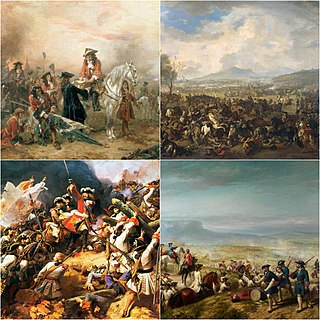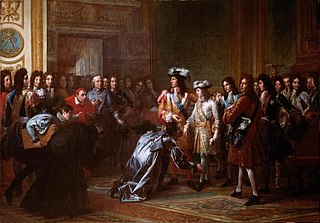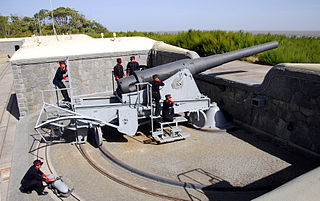
The War of the Spanish Succession was a European great power conflict fought between 1701 and 1714. The immediate cause was the death of the childless Charles II of Spain in November 1700, which led to a struggle for control of the Spanish Empire. His nominated heir was Philip of Anjou, a grandson of Louis XIV of France, whose main backers were France and most of Spain. His rival, Archduke Charles of Austria, was supported by the Grand Alliance, whose primary members included the Holy Roman Empire, the Dutch Republic, and Great Britain. Significant related conflicts include the 1700 to 1721 Great Northern War, and Queen Anne's War in North America.

Leopold I was Holy Roman Emperor, King of Hungary, Croatia, and Bohemia. The second son of Ferdinand III, Holy Roman Emperor, by his first wife, Maria Anna of Spain, Leopold became heir apparent in 1654 after the death of his elder brother Ferdinand IV. Elected in 1658, Leopold ruled the Holy Roman Empire until his death in 1705, becoming the second longest-ruling Habsburg emperor. He was both a composer and considerable patron of music.

Charles VI was Holy Roman Emperor and ruler of the Austrian Habsburg monarchy from 1711 until his death, succeeding his elder brother, Joseph I. He unsuccessfully claimed the throne of Spain following the death of his relative, Charles II. In 1708, he married Elisabeth Christine of Brunswick-Wolfenbüttel, by whom he had his four children: Leopold Johann, Maria Theresa, Maria Anna, and Maria Amalia.

The Southern Netherlands, also called the Catholic Netherlands, were the parts of the Low Countries belonging to the Holy Roman Empire which were at first largely controlled by Habsburg Spain and later by the Austrian Habsburgs until occupied and annexed by Revolutionary France (1794–1815).

Alfred Ritter von Arneth was an Austrian historian. His principal scholarly work is a ten-volume biography of the Habsburg Empress Maria Theresa, first published in installments from 1863 to 1879 and still regarded as the standard work on the subject. Born at Vienna, he was the son of Joseph Calasanza von Arneth (1791–1863), a well-known historian and archaeologist, who wrote a history of the Austrian Empire and several works on numismatics and brother of Doctor Franz Hektor von Arneth (1818–1907).

The Ostend Company, officially the General Company Established in the Austrian Netherlands for Commerce and Navigation in the Indies was a chartered trading company in the Austrian Netherlands in the Holy Roman Empire which was established in 1722 to trade with the East and West Indies. It took its name from the Flemish port city of Ostend.

The United Belgian States, also known as the United States of Belgium, was a short-lived confederal republic in the Southern Netherlands established under the Brabant Revolution. It existed from January to December 1790 as part of the unsuccessful revolt against the Habsburg Emperor, Joseph II.

Maria Christina, Duchess of Teschen, was the fifth child of Maria Theresa of Austria and Francis I, Holy Roman Emperor. Married in 1766 to Prince Albert of Saxony, the couple received the Duchy of Teschen, and she was appointed Governor of the Austrian Netherlands jointly with her husband during 1781–1789 and 1791–1792. After two expulsions from the Netherlands, she lived with her husband in Vienna until her death.

The Barrier Treaties were a series of agreements signed and ratified between 1709 and 1715 that created a buffer zone between the Dutch Republic and France by allowing the Dutch to occupy a number of fortresses in the Southern Netherlands, ruled by the Spanish or the Austrians. The treaties were cancelled by Austria in 1781.

The Treaty of Den Haag, or Treaty of The Hague, was signed on 7 September 1701 between England, the Holy Roman Emperor Leopold I, and the United Provinces. It reconstituted the 1689 anti-French Grand Alliance in response to the issues that resulted in the War of the Spanish Succession.

Louis Ernest of Brunswick-Lüneburg-Bevern was a field-marshal in the armies of the Holy Roman Empire and the Dutch Republic, the elected Duke of Courland (1741). From 13 November 1750 to 1766 he was the Captain-General of the Netherlands, where he was known as the Duke of Brunswick or Duke of Brunswick-Wolfenbüttel. Another brother was Duke Ferdinand of Brunswick who led the Allied Anglo-German army during the Seven Years' War.

SMS Kaiserin und Königin Maria Theresia was an armored cruiser used by the imperial Austro-Hungarian Navy from 1895 to 1917; she was the first ship of that type built by the Austro-Hungarian Navy. The ship was a unique design, built by the Stabilimento Tecnico Triestino shipyard in Trieste; she was laid down in July 1891, launched in April 1893, and completed in November 1894. Armed with a main battery of two 24-centimeter (9.4 in) guns and eight 15 cm (5.9 in) guns, the ship provided the basis for two subsequent armored cruiser designs for the Austro-Hungarian Navy.
The Treaty of Fontainebleau was signed on November 8, 1785 in Fontainebleau between Holy Roman Emperor Joseph II, ruler of the Habsburg monarchy, and the States-General of the United Provinces. Based on the terms of the accord, the United Provinces could maintain sovereignty over the Scheldt Estuary but had to provide several concessions to the Habsburgs, including the payment of ten million Dutch florins and the dismemberment of certain military fortifications. Overall, the treaty confirmed and reinforced the tenets of the Treaty of Münster.
HNLMS Dolfijn may refer to following ships of the Royal Netherlands Navy:

SMS Kaiser Karl VI was the second of three armored cruisers built by the Austro-Hungarian Navy. She was built by the Stabilimento Tecnico Triestino in Trieste between June 1896 and May 1900, when she was commissioned into the fleet. Kaiser Karl VI represented a significant improvement over the preceding design—Kaiserin und Königin Maria Theresia—being faster and more heavily armed and armored. She provided the basis for the third design, Sankt Georg, which featured further incremental improvements. Having no overseas colonies to patrol, Austria-Hungary built the ship solely to reinforce its battle fleet.
Austrian East India Company is a catchall term referring to a series of Austrian trading companies based in Ostend and Trieste. The Imperial Asiatic Company of Trieste and Antwerp and Asiatic Company of Trieste or the Trieste Company were founded by William Bolts in 1775 and wound up in 1785.

The 24 cm K L/35 was a German naval gun developed in the years before World War I that armed ships of the Imperial German Navy, Argentine Navy and the Austro-Hungarian Navy. Guns removed from ships of the Imperial German Navy were modified to perform Coastal Artillery and Railway Artillery roles and saw service in both world wars. The actual bore diameter was 23.8 cm (9.4 in), but the classification system for artillery rounded up to the next highest centimeter.

The Kaiser Franz Joseph I class was a class of two protected cruisers built for the Austro-Hungarian Navy. Named for Austro-Hungarian Emperor Franz Joseph I, the class comprised SMS Kaiser Franz Joseph I and SMS Kaiserin Elisabeth. Construction took place throughout the late 1880s, with both ships being laid down in 1888. Kaiser Franz Joseph I was built by Stabilimento Tecnico Triestino in Trieste, while Kaiserin Elisabeth was built at the Pola Navy Yard in Pola. The Kaiser Franz Joseph I-class ships were the first protected cruisers constructed by the Austro-Hungarian Navy. Kaiser Franz Joseph I was the first ship of the class to be commissioned into the fleet in July 1890. She was followed by Kaiserin Elisabeth in November 1892.

SMS Kaiser Franz Joseph I was a protected cruiser built for the Austro-Hungarian Navy. Named for the Austrian emperor and Hungarian king Franz Joseph I, Kaiser Franz Joseph I was the lead ship of her namesake class. Constructed by Stabilimento Tecnico Triestino in Trieste, she was laid down in January 1888 and launched in May 1889. Kaiser Franz Joseph I was commissioned into the Navy in June 1890. As the first protected cruiser constructed by the Austro-Hungarian Navy, she was intended to serve as Austria-Hungary's response to the Italian cruisers Giovanni Bausan and Etna. Her design was heavily influenced by the Jeune École, a naval strategy which had gained prominence in the 1880s as a means to combat a larger and more heavily armored navy of battleships through the use of torpedo flotillas.



















